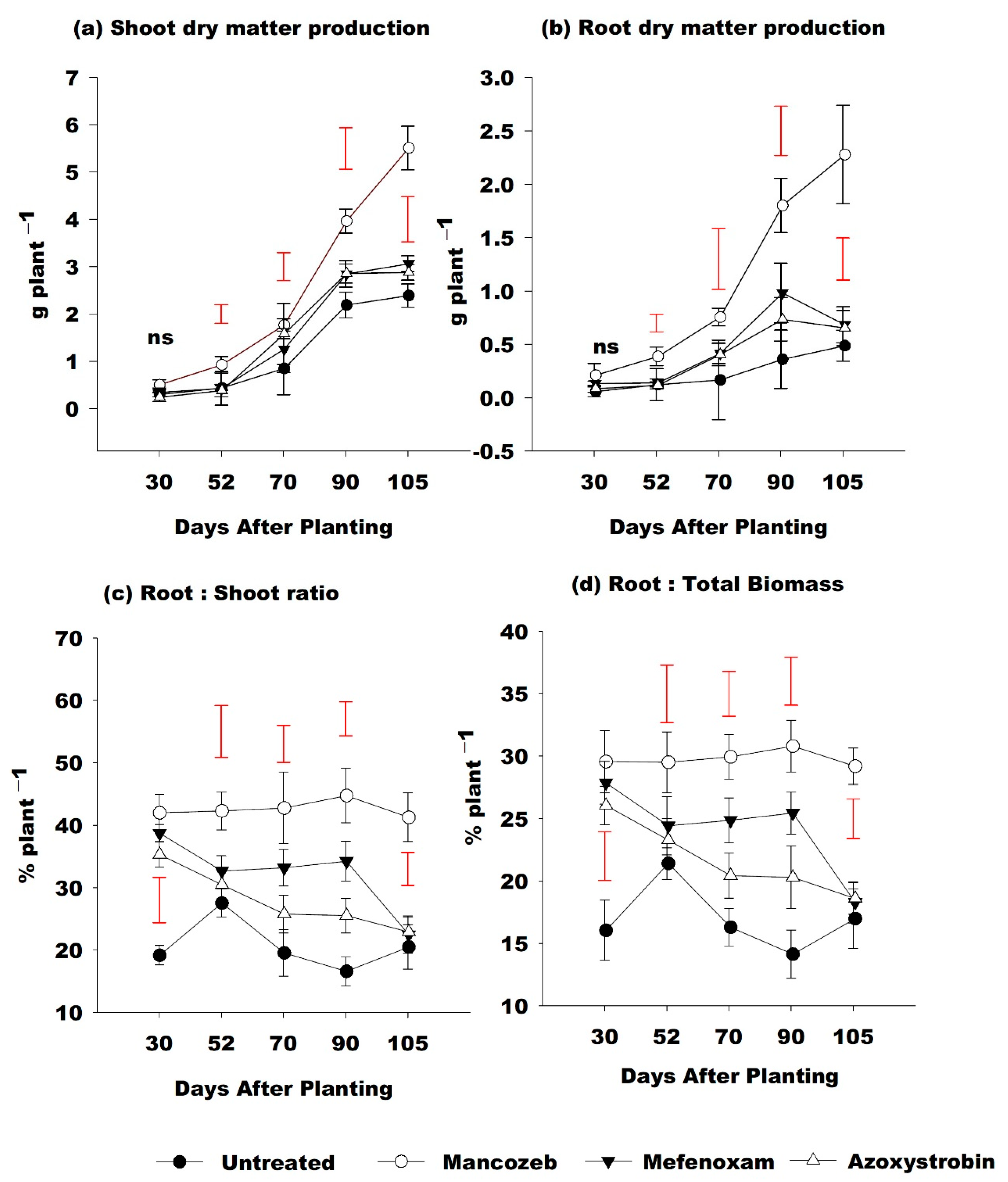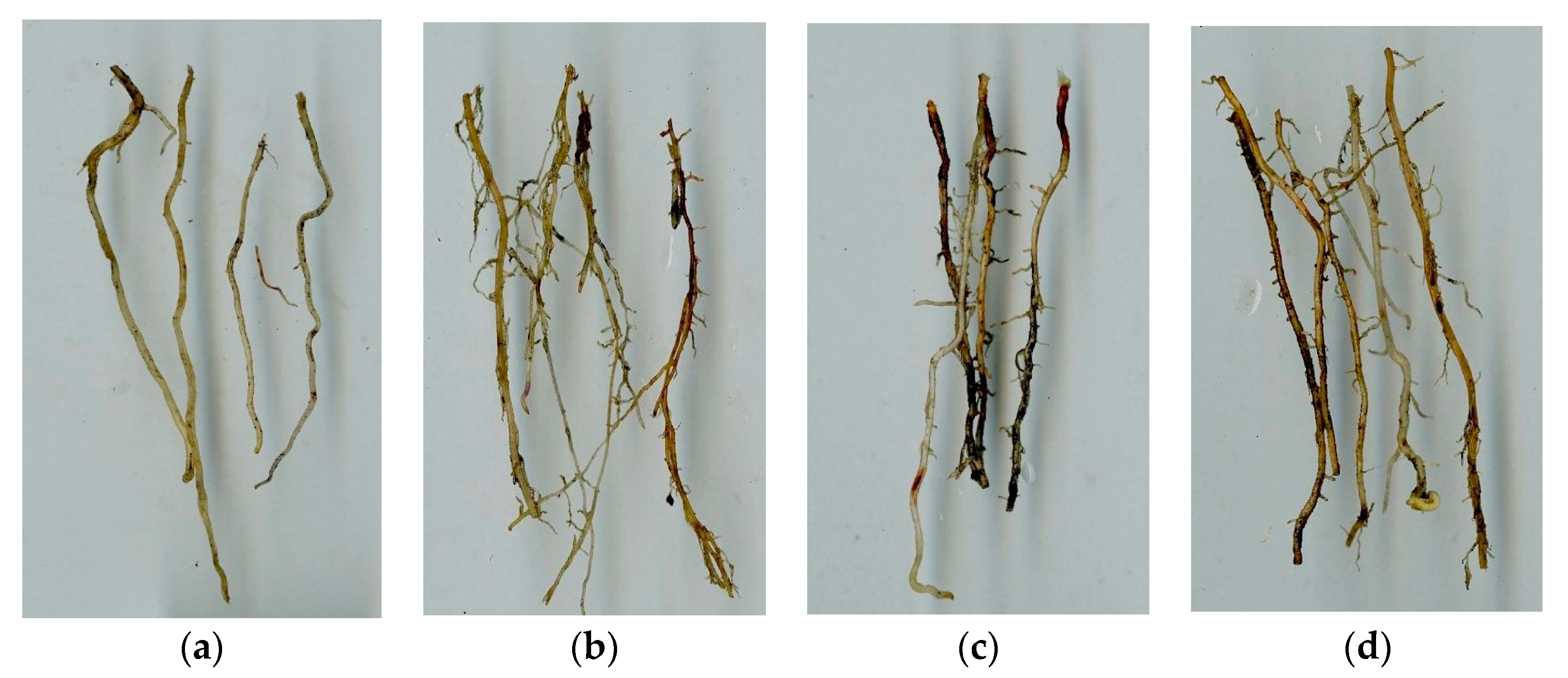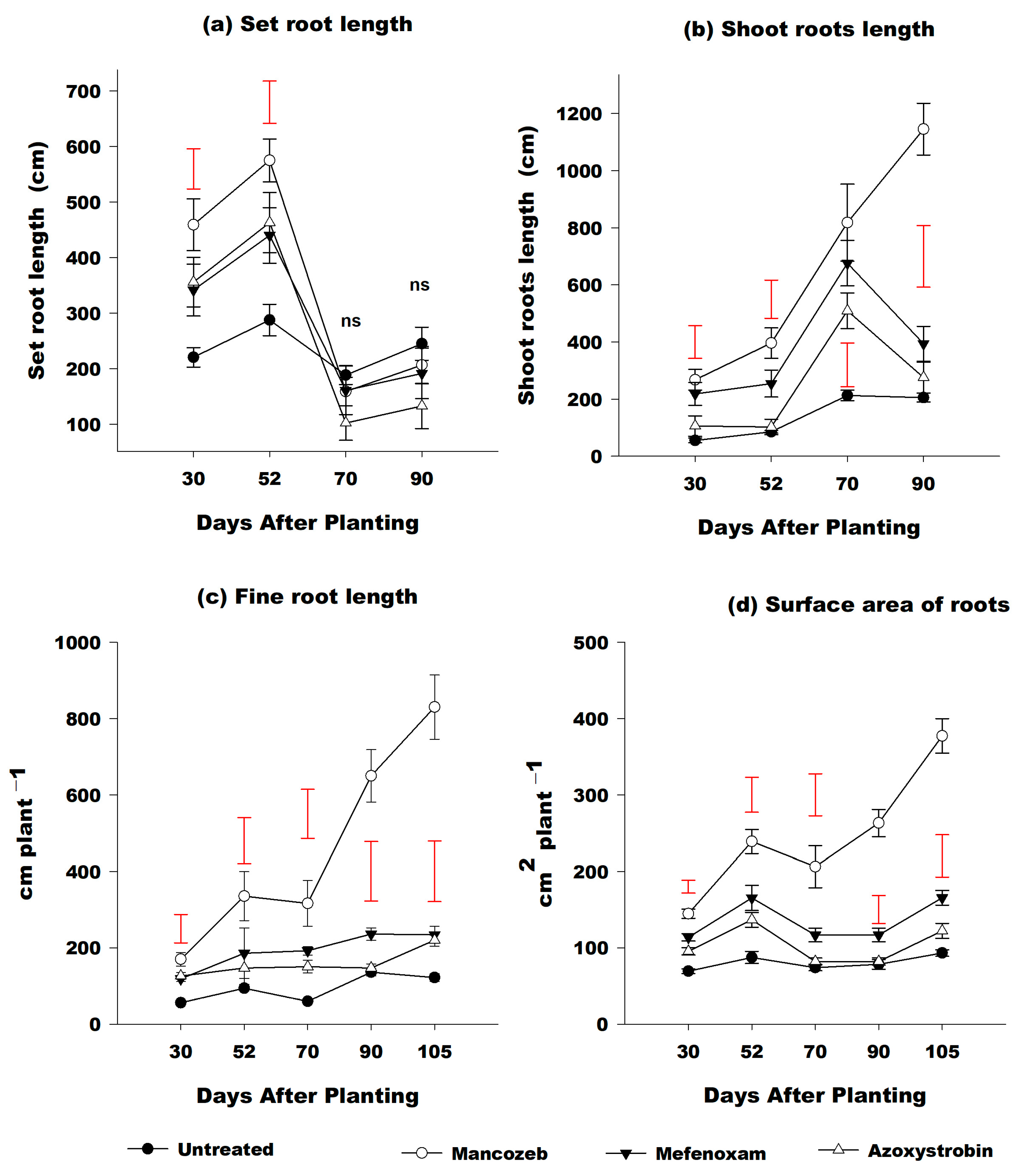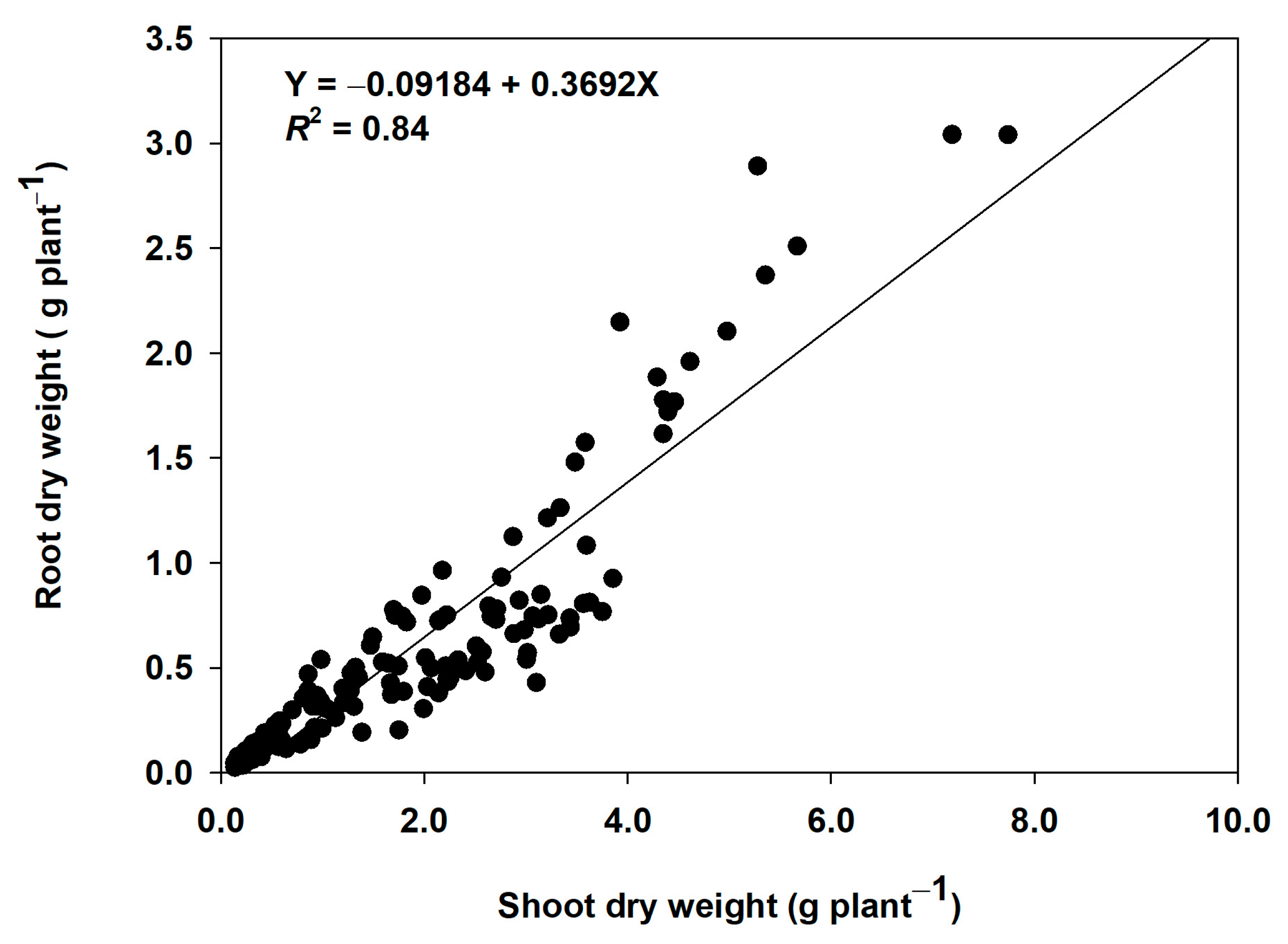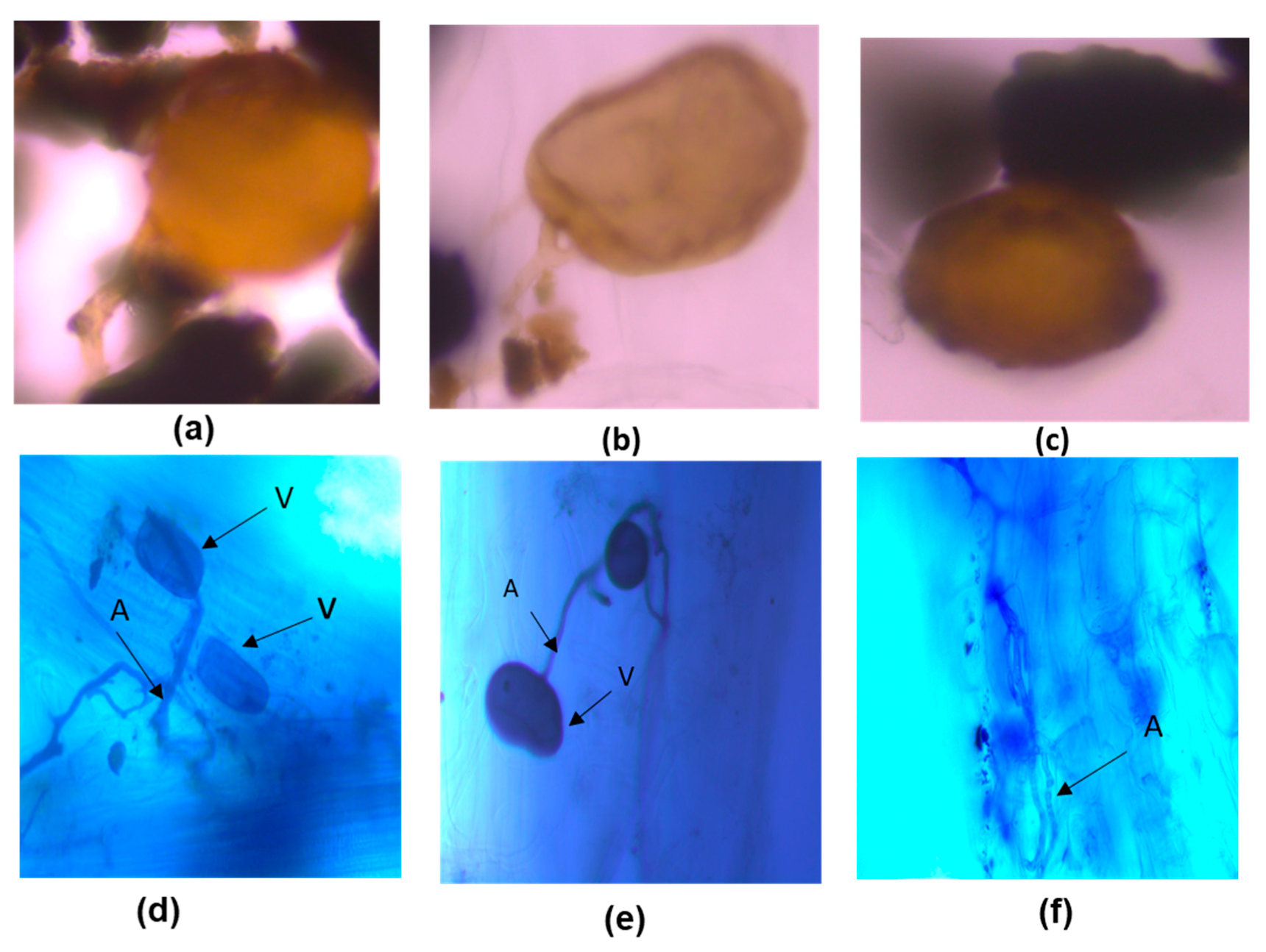1. Introduction
A perennial grass, sugarcane (
Saccharum spp. hybrid) experiences yield decline under prolonged monoculture (also called successive planting). Magarey [
1] demonstrated that this decline is evidenced by poor root health associated with soil-borne root pathogens, many of them fungi. Poor-root-syndrome occurrence in many sugarcane-producing countries suggests the prevalence of
Pythium arrhenomanes, and pathogenicity tests show severe damage to fine-root systems and reductions in shoot growth [
2]. Loss of more than 80% of the primary shoot-root system weakens the structural stability of the stool, increasing the likelihood of stalks toppling over.
Pythium root rot, confined to the fine-root system, does not cause a level of damage to result in toppling over. This occurs with
Pachymetra primary root rot, an endemic disease to the sugarcane belt of Australia. Apart from
P. arrhenomanes, several other species of
Pythium,
Pachymetra chaunorhiza (Pachymetra root rot),
Rhizoctonia spp., dematiaceous or dark sterile fungi are also known to damage the sugarcane-root system [
3,
4]. Visible root symptoms, such as roots devoid of root hairs or the absence of a fine-root system, inhibit nutrient and water uptake and therefore reduce plant vigor. Pineapple sett-rot disease, caused by
Ceratocystis paradoxa, is also reported to be more prevalent in soils with successive sugarcane planting. The pathogen attacks seed cane through the cut ends, thereby causing seed-piece decay and patchy germination [
5].
Sugarcane planting or propagation is commonly vegetative, using stem cuttings that have lateral buds on each node. After planting, the growth phase starts with the emergence of sett roots from a band of root primordia above the leaf scar on the nodes of the sett. Early sett roots are finely branched roots and sustain the growing bud in the first few weeks after planting. These roots later start senescing and disappear 60 to 90 days after planting [
6]. In the second growth phase, shoot roots emerge from the base of the new shoot and are typically thicker than sett roots. Finally, the shoot roots develop into the main root system of the plant. Deleterious fungi may attack the developing root system within days of planting, slowing down primary shoot growth and subsequent production and growth of secondary shoots or tillers [
7,
8]. Previous studies in Australia showed the application of benomyl and dithiocarbamate (mancozeb, maneb, and zineb) fungicides in monoculture soils improved sugarcane-root and -shoot growth [
9]. Mancozeb dose (25–400 mg a.i. (active ingredient) kg
−1 soil) response studies showed a higher rate of root-growth improvement with each increment from 25 to 100 mg a.i. kg
−1 soil, but the response was low after 100 mg a.i. kg
−1 soil [
10]. The root-growth response with fungicides such as benomyl and analazin was low compared to mancozeb [
11]. In Louisiana soils, 16% to 27% plant-cane and ratoon growth enhancements were observed with application of the oomycete-specific fungicide metalaxyl [
12].
A healthy sugarcane-root system with numerous fine roots offers greater surface area, which will increase the diffusive supply of soil immobile nutrients. Arbuscular mycorrhizal fungi (AMF) and their symbiotic association with plant roots through the formation of extraradical hyphae also contribute to the absorption of immobile soil nutrients [
13]. Histosols in the Everglades Agricultural Area (EAA) are generally low in the recommended levels of available soil phosphorus (Mehlich-3 P < 40 mg kg
−1 soil) as established for sugarcane [
14]. Whenever soil P levels are low, mycorrhizal association is said to be beneficial in terms of supply of P, Cu and Zn nutrients to the associated plant [
15]. Mycorrhizae can also cause detrimental effects on plant growth during initial stages of growth as developing hyphal network continue to draw sugars from the host plant [
16]. As reported by Hendrix et al. [
16] and Johnson et al. [
17], mycorrhizal association with sugarcane causes negative impact on plant growth whenever soil P levels are high. Research conducted on citrus seedlings with the soil application of copper, metalaxyl-M, thiobendazole fungicides, even at low concentrations, prevented mycorrhizal-fungi root colonization and subsequent growth reduction [
18]. Sensitivity of AM fungi towards soil-applied fungicides was mixed, ranged from no impact to complete elimination, and reduced or increased root infections in different crops [
19,
20].
Mancozeb (coordination product of zinc ion and manganese ethylene bis-dithocarbamate) is a broad-spectrum contact fungicide used in agriculture, turf management, and horticultural crops [
21]. Mefenoxam is a systemic phenyl amide fungicide (R-enantiomer of metaloxyl) and is effective against diseases caused by
Pythium spp. and
Phytophtohora spp. [
22]. Azoxystrobin is a systemic fungicide belonging in the strobilurin group and is used to control several pathogenic Ascomycota, Basidiomycota, Deuteromycota, and Oomycota fungi causing diseases to a wide range of crops [
23]. Strobilurins are spore-germination inhibitors, known as QoI fungicides as they inhibit mitochondrial respiration by binding the quinol oxidation site and stop electron transfer between cytochrome b and c [
24]. Due to the systemic and broad-spectrum activity of azoxystrobin, it has been used as an in-furrow spray and in soil-drench applications in different crops at the seedling stage [
25].
Management of sugarcane yield decline in successive planting is well researched in Australia [
26]. There were no reports available on sugarcane-monoculture yield-decline management in Histosols. To test the efficacy of fungicides in Histosols, we hypothesized that soil-applied fungicide may reduce the influence of detrimental fungal root pathogens, thereby enhancing root health. This would be reflected in greater shoot biomass and uptake of nutrients in the soil such as nitrogen, phosphorus, copper, zinc, iron, and silicon. The specific objectives of the study were: (i) to determine the effects of soil-applied fungicides on early root and shoot growth of sugarcane; (ii) to understand the effect of soil-applied fungicides on rhizosphere microbial communities and on the mycorrhizal colonization of roots; and iii) to determine the uptake of immobile soil nutrients as an indicator of a healthy or weak fine-root system of the sugarcane plant.
2. Materials and Methods
2.1. Pot Experiment Setup
A two-year (2016 and 2017) greenhouse study was conducted at the EREC (Everglades Research and Education Center), Belle Glade, Florida to determine the effect of fungicides on soil early plant growth and soil properties. Identical experimental and data-collection procedures were used during both years, with the second year (2017) being a repetition of first trial (2016). The soil used in this study was obtained from a sugarcane field that was under a long-term (>20 years) monoculture. Located at the EREC experimental farm, Belle Glade, Florida, the soil type was Histosol or Pahokee series muck (euic, hyperthermic Lithic Haplosaprist) with a pH of 7.4, 82% of organic matter, 2.3% of N, 46 ppm of P, 112 ppm of K, 7.19 ppm of Cu, 1.05 ppm of Mn, 32.5 ppm of Zn, 14 ppm of Fe, 20 ppm of Si, and 277 ppm of S. topsoil (0–15 cm depth) was excavated from an area adjacent to the stubble region and was passed through a 4 mm sieve. Plastic pots (1.7 L; 15.8 cm diameter × 15.0 cm depth) were uniformly filled with 1.25 ± 0.05 kg of field-moist soil (dry bulk density, 0.38 g cm
3) in each pot. All pots were fertilized with a nutrient mix at 450 mg pot
−1, containing 3.05% of P, 21.58% of K, 31.73% of S, 0.88% of Mn, 0.24% of Cu, 0.30% of Zn, and 0.12% of B, respectively. Fertilizer rates were calculated based on the surface area of each pot and established soil test-based nutrient recommendations for sugarcane grown on Histosols in Florida [
27]. Single-budded seed pieces (with a 2 cm stalk on either side), obtained from the middle of mature stalks of the sugarcane cultivar CP 96-1252 [
28] were first planted in greenhouse flat trays (27.5 cm width × 53.5 cm length × 7.0 cm depth) to ensure uniformity in germination before transplanting to the pots. We used double the number of single-budded cuttings than required for transplanting into the pots. Each tray was planted with 25 buds and 6 trays were used per each treatment. At 3 weeks after planting, similarly sized seedlings were selected and transplanted to pots with one seedling per pot. The study was conducted during both years during sugarcane-planting season (October to mid January), and inside greenhouse temperature during the day was 32–38 °C, 22–25 °C at night, with a relative humidity of 60%.
2.2. Fungicides Application
Commercial formulations of mancozeb at 250 μg mL
−1 (Manzate
® 75DF, Griffin L.L.C, Valdosta, GA, USA), azoxystrobin at 30 μg mL
−1 (Quadris
® 2.08SC, Syngenta Corporation, Greensboro, NC, USA), mefanoxam at 55 μg mL
−1 (Ridomil Gold
® 2E, Syngenta Corporation, Greensboro, NC, USA) in 200 mL of water were applied as soil drench in each pot. The untreated pots were drenched only with 200 mL water. The use of 200 mL water was based on the preliminary test that was conducted to estimate the amount of water needed to drench the soil in one pot. Fungicide concentrations were calculated based on the surface area of the pots compared to the fungicide-treated surface area in a one-hectare application rate in the field (
Table 1). In field, the fungicide is normally applied in a 0.15 m wide band in each furrow with 1.5 m inter-furrow spacing. So, the total fungicide-treated area in one hectare was considered to be (10,000 m
2/1.5 m) × 0.15 m = 1000 m
2 in calculating fungicide concentration for the pots. There were 75 pots in each treatment (total 300 pots in 4 treatments) that were arranged in a completely randomized design on greenhouse benches. Soil used in the flat trays for seed-piece germination was treated with fungicides at 1.5× times the concentration used in those of pots in 1 L drench volume. As mancozeb contains 15% of Mn and 1.9% of Zn, the other treatments were compensated for these nutrients through fertilization. After fungicide application, a thin layer of soil was spread over the top of the pot or tray to reduce evaporation losses.
2.3. Growth Measurements
Emergence percentage was estimated by counting the number of buds that emerged from the greenhouse flat trays, and the rest of the growth measurements were conducted after transplanting the seedlings in pots. Primary shoot length was measured from the plant base to the base of the top visible dewlap (TVD) leaf. The total number of primary, secondary, and tertiary shoots (also called tillers) were counted until final harvest (at 105 days after planting, (DAP)) of the experiment. Plants were harvested after 30, 52, 70, 90, and 105 DAP to measure root and shoot growth. At each harvest, 10 randomly selected plants were carefully uprooted without damaging the root system. Set roots and shoot roots were separated at 30, 52, 70, and 90 DAP, while at 105 DAP, set roots could not be separated from shoot roots because of their very small proportion compared to shoots roots. Roots were washed on a 2 mm mesh screen to remove adhering soil particles. The washed-root images were acquired on greyscale at a resolution of 800 dpi with the help of an Epson LA 2400 flatbed scanner (Epson America, Inc., Long Beach, CA, USA) equipped with an overhead transparency unit (TPU) and a special lighting system to prevent any potential shadows while scanning. The set- and shoot-root lengths, surface area, and root diameters were determined from the scanned root images using WinRHIZO regularTM 2016 (Regent Instruments, Québec, QC, Canada) root image-analysis software. For a better understanding of the fine roots, root diameter classes were set at 0.2 mm class interval. The class with <0.2 mm diameter were considered as fine roots to determine their relationship with tissue centration and uptake of less-mobile nutrients in the soil. Roots and shoots were dried for 72–80 h at 70 °C in a hot-air oven until constant mass was achieved. Root:shoot ratio, total biomass, and root:total biomass ratios were calculated on a constant oven-dry weight basis.
2.4. Phospholipid Fatty Acid (PLFA) Analyses
After 70 days of growth, 16 plants were uprooted from each treatment and roots were shaken vigorously and gently rubbed against each other in a sterile whirl-pak bag (Nasco, whirlpak
TM, Fort Atkinson, WI, USA) to collect rhizosphere soil. The rhizosphere soil from 4 plants was combined in 1 composite sample with a total of 4 replicates, and microbial community analysis was performed by following a high-throughput PLFA procedure for soils [
29]. One gram of freeze-dried soil was extracted with a Bligh–Dyer solution added with internal standard (19:0 phosphatidylcholine, Avanti Polar Lipids, Inc. Alabaster, AL, USA). Phospholipids were separated from neutral and glycolipids classes by solid-phase extraction (SPE) using a 96-well SPE plate preloaded with 50 mg silica per well. Phospholipids were eluted with 0.5 mL of 5:5:1 methanol:chloroform:water into 1.5 mL glass vials. Phospholipids were trans-esterified by adding 200 µL of a reagent mixture containing potassium hydroxide (KOH); methanol and toluene. PLFAs were extracted with hexane and analyzed by gas chromatography (Hewlett Packard 6890 series gas chromatograph, Agilent Technologies Inc., Santa Clara, CA, USA). Different peaks in the chromatograph were identified with the MIDI PLFAD1 (MIDI labs Inc., Newark, DE, USA) calibration mix and peak naming table. Individual PLFA biomarkers (n mole g
−1 dry soil) were assigned to different functional groups of microorganisms. The PLFA biomarkers were the sum of PLFAs i15:0, a15:0, i16:0, i17:0, and a17:0 for Gram + ve bacteria [
30,
31], sum of cy17:0, 16:1ω7, 18:1ω7, and 17:1ω9 for Gram − ve bacteria [
32], and sum of 10Me16:0, 10Me17:0, and 10Me18:0 for Actinomycetes [
33]. The fungal biomarkers included 18:2ω6 for fungi [
34] and 16:1 ω5 for arbuscular mycorrhizal fungi [
35]. Total bacteria were expressed as the sum of Gram + ve bacteria, Gram − ve bacteria, and Actinomycetes. The fungi to bacteria ratio was expressed by dividing the fungal biomarker (18:2 ω6) with total bacteria [
36].
2.5. Mycorrhizal Spore Density and Root-Colonization Studies
Pot experiments with the soil application of fungicides involving initial growth studies are difficult to conclude without mycorrhizal association studies. In the present study, we included mycorrhizal colonization (%) of roots and spore counts primarily to know any possible suppression or increased root colonization and sporulation after the soil-drench application of fungicides. In the follow-up experiment in 2017, at 70 DAP, 20 plants were randomly selected from each treatment and composited to 4 replicates to conduct the mycorrhizal-colonization and spore-count studies. Root infections by mycorrhizal fungi were determined by loading root subsamples into a tissue cassette (Fisher Scientific, Pittsburgh, PA, USA). These tissue samples were immersed in 10% KOH and autoclaved at 110 °C for 3 min. After brief cooling, the roots were bleached with clorox and thoroughly rinsed to remove KOH and clorox residues. Cassettes were soaked in 1% HCl and kept overnight in 0.05% trypan blue for staining [
37]. The stained roots were cut into 1 cm pieces and mounted in batches of 10 on microscopic slides to observe under a compound microscope at 10× and 40× magnifications. The extent of mycorrhizal colonization was visually determined according to the root-slide method [
38] with a Leica DM300 compound microscope (Leica Microsystems Inc. Buffalo Grove, IL, USA). Mycorrhizal spore counts were conducted by wet sieving 10 g of soil followed by centrifugation in sucrose [
39,
40]. Spore identification was based on mycorrhizal-spore pictures showing thick-walled chlamydospores that are produced by
Glomus spp. These spores were further categorized based on morphological features such as size, shape, and wall-ornamentation characters and compared with standard specimens of
Glomus spp. [
41].
2.6. Nutrient Uptake
Shoots of 5 potted plants were composited in each replicate (with a total of 4 replicates) for tissue-nutrient composition. Shoots were dried at 70 °C for 4 to 6 days in a hot-air oven until constant weight was attained. Oven-dried tissues were ground in a Willey plant-tissue grinding mill (Thomas Scientific, Swedesboro, NJ, USA) fitted with a 1 mm sieve and were used for nutrient-concentration determination. Total Kjeldahl Nitrogen (TKN) concentration of tissue samples was obtained by digesting 0.10 g of the ground tissue with 3.5 mL concentrated H
2SO
4 and 1.0 g Kjeldahl digestion mixture (10 g K
2SO
4 + 0.30 g CuSO
4) for 3.5 h at 160 °C to 380 °C temperature in a block digester. TKN content was determined by following the semiautomated colorimetric analytical procedure in the digested samples by method 351.2 [
42]. Tissue P, Mg, Zn, Cu, and Fe were determined after ashing 0.4 g of the ground sample at 500 °C for 12 h [
43]. The ash was dissolved in 2 mL of 6.0 M HCl and concentration of elements in the extraction was determined by inductively coupled plasma-emission spectrometer (Agilent 5110 ICP-OES, Santa Clara, CA, USA). Silicon concentration of tissues was determined by following the colorimetric procedure after autoclave-induced digestion [
44]. Stunted plants are likely to have greater nutrient concentration, and to overcome possible nutrient dilution with higher growth achieved in fungicide-treated plants, nutrient uptake was also included in the study.
2.7. Statistical Analyses
Statistical analyses were performed using SAS statistical software (SAS 9.4, SAS Institute Inc., Cary, NC, USA). Proc univariate was used to test the normality and homogeneity of variance assumptions of ANOVA (Analysis of variance) with normal P-P and Q-Q plots. Data on shoot- and root-growth measurements, collected during both years, were combined, as the variance was homogeneous. Proc GLM was performed to compare the effect of treatments on various parameters measured in the study. Multiple comparisons of post-hoc pairwise treatment means were compared with Tukey’s HSD test at α = 0.05 whenever ANOVA indicated significant differences (p ≤ 0.05). Allometric relationship between root and shoot biomass was visualized with simple linear regression. Pearson correlation analyses were performed to determine the relationship between mycorrhizal-spore density, root parameters with aboveground biomass, and nutrient concentrations.
